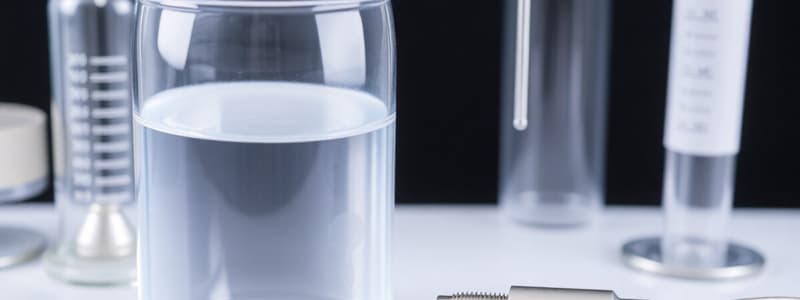Podcast
Questions and Answers
What is the primary purpose of polarography?
What is the primary purpose of polarography?
Which device is commonly associated with polarography?
Which device is commonly associated with polarography?
Which of the following methods is NOT typically classified as a polarography method?
Which of the following methods is NOT typically classified as a polarography method?
What type of information can polarography provide?
What type of information can polarography provide?
Signup and view all the answers
In which scenario is polarography typically applied?
In which scenario is polarography typically applied?
Signup and view all the answers
Which of the following best describes the significance of polarography?
Which of the following best describes the significance of polarography?
Signup and view all the answers
What requirement should one know before studying polarography?
What requirement should one know before studying polarography?
Signup and view all the answers
Which statement about the dropping mercury electrode is true?
Which statement about the dropping mercury electrode is true?
Signup and view all the answers
What is the typical range for the temperature coefficient?
What is the typical range for the temperature coefficient?
Signup and view all the answers
Which factor has a sixth root power effect on the diffusion current?
Which factor has a sixth root power effect on the diffusion current?
Signup and view all the answers
How can the diffusion current be accurately controlled?
How can the diffusion current be accurately controlled?
Signup and view all the answers
What does the interfacial tension at the mercury surface affect?
What does the interfacial tension at the mercury surface affect?
Signup and view all the answers
Increasing the temperature affects the diffusion current how?
Increasing the temperature affects the diffusion current how?
Signup and view all the answers
What happens to the viscosity and diffusion current when the concentration of solution is low?
What happens to the viscosity and diffusion current when the concentration of solution is low?
Signup and view all the answers
In the context of complex formation, how does movement of metal ions vary when hydrated complexes are formed?
In the context of complex formation, how does movement of metal ions vary when hydrated complexes are formed?
Signup and view all the answers
What variable is described in the empirical relation related to the diffusion coefficient from Stoke’s Einstein formula?
What variable is described in the empirical relation related to the diffusion coefficient from Stoke’s Einstein formula?
Signup and view all the answers
What does E1/2 represent in a redox reaction?
What does E1/2 represent in a redox reaction?
Signup and view all the answers
Which equation is utilized to understand the potential and current of a redox system?
Which equation is utilized to understand the potential and current of a redox system?
Signup and view all the answers
What must be achieved to know the exact E1/2 value?
What must be achieved to know the exact E1/2 value?
Signup and view all the answers
What happens when the voltage in a polarographic experiment is increased?
What happens when the voltage in a polarographic experiment is increased?
Signup and view all the answers
In polarography, what does the equation I = [Ox] - [Oxs] represent?
In polarography, what does the equation I = [Ox] - [Oxs] represent?
Signup and view all the answers
Which factor does NOT influence the kinetics of current in a polarographic system?
Which factor does NOT influence the kinetics of current in a polarographic system?
Signup and view all the answers
What is the role of surface active materials in polarography?
What is the role of surface active materials in polarography?
Signup and view all the answers
How can you predict the element present in a solution using E1/2?
How can you predict the element present in a solution using E1/2?
Signup and view all the answers
What effect does the addition of alcohol have on the viscosity of a solution?
What effect does the addition of alcohol have on the viscosity of a solution?
Signup and view all the answers
What is the polarographic maxima?
What is the polarographic maxima?
Signup and view all the answers
What is a distinguishing feature of the strike streaming type mechanism?
What is a distinguishing feature of the strike streaming type mechanism?
Signup and view all the answers
How can the difficulties caused by polarographic maxima be managed?
How can the difficulties caused by polarographic maxima be managed?
Signup and view all the answers
What causes the non-streaming maxima?
What causes the non-streaming maxima?
Signup and view all the answers
What is the outcome of polarographic maxima on the diffusion current measurement?
What is the outcome of polarographic maxima on the diffusion current measurement?
Signup and view all the answers
What happens to the V-I curve as the applied voltage increases in a polarogram exhibiting maxima?
What happens to the V-I curve as the applied voltage increases in a polarogram exhibiting maxima?
Signup and view all the answers
What is a likely result of having low viscosity in a polarographic analysis?
What is a likely result of having low viscosity in a polarographic analysis?
Signup and view all the answers
What is the primary factor measured in a cyclic voltammetry (CV) curve to evaluate the concentration of dissolved oxygen?
What is the primary factor measured in a cyclic voltammetry (CV) curve to evaluate the concentration of dissolved oxygen?
Signup and view all the answers
In polarography, what is the significance of using a masking reagent?
In polarography, what is the significance of using a masking reagent?
Signup and view all the answers
What is the tolerable limit difference in E1/2 for best estimations in polarography when several ions are present?
What is the tolerable limit difference in E1/2 for best estimations in polarography when several ions are present?
Signup and view all the answers
When using the standard addition method in polarography, what is the first step before determining the concentration of an unknown sample?
When using the standard addition method in polarography, what is the first step before determining the concentration of an unknown sample?
Signup and view all the answers
For the estimation of Cu2+ in polarography, which reagent can be used to form a complex?
For the estimation of Cu2+ in polarography, which reagent can be used to form a complex?
Signup and view all the answers
What is the purpose of measuring the height between two plateaus in polarography?
What is the purpose of measuring the height between two plateaus in polarography?
Signup and view all the answers
What is required to estimate the concentration of an unknown ion using the internal addition of a pilot ion?
What is required to estimate the concentration of an unknown ion using the internal addition of a pilot ion?
Signup and view all the answers
What is the role of a maxima suppressor in the determination of ions in polarography?
What is the role of a maxima suppressor in the determination of ions in polarography?
Signup and view all the answers
Study Notes
Polarography
- A technique that studies the relationship between current and potential, specifically at a dropping mercury electrode (DME)
- Used for qualitative and quantitative analysis of electroactive species, including metals, ions, and organic molecules.
- The heart of polarography is the DME, a mercury electrode that generates continuously renewable droplets, allowing for a fresh surface.
Polarographic Maxima
- Abnormalities in the current-voltage curve.
- Appear as abnormal increases in current before returning to the normal diffusion current curve.
- Types:
- Strike Streaming Type: Caused by low base electrolyte concentration and high active species concentration, resulting in rapid diffusion.
- Non-streaming Maxima: Occurs due to increased pressure on the DME, leading to quick mercury drop formation and broad maxima.
Methods for Suppressing Maxima
- Surface-active Agents: Adding substances that reduce the surface tension, such as surfactants, dyes, or capillary-active ions.
Diffusion Current (ID)
- The limiting current (plateau current) reached after the potential rises beyond a certain value.
- Directly proportional to the concentration of the electroactive species.
- Influenced by factors such as temperature, pressure, complex formation, interfacial surface tension, and the diffusion coefficient.
Half-Wave Potential (E1/2)
- The potential at which the diffusion current is half of the total current.
- A characteristic feature of the electroactive species, providing qualitative information about the element present.
- Measured from the middle point of the rising portion of the polarographic curve.
Measuring Concentration using Polarography
- Standard Addition Method: A known amount of standard solution of the same ion is added to the unknown sample, and the change in wave height is used to determine the initial concentration.
- Internal Addition of Pilot Ion: A known amount of a pilot ion (with a known E1/2) is added to the unknown sample. Comparing the wave heights of the unknown ion and the pilot ion allows for the determination of the unknown concentration.
Studying That Suits You
Use AI to generate personalized quizzes and flashcards to suit your learning preferences.
Related Documents
Description
This quiz covers the fundamentals of polarography, emphasizing the relationship between current and potential in electrochemical analysis. It explores the phenomena of polarographic maxima and methods for suppressing these abnormalities, particularly through the use of surface-active agents. Test your knowledge of this important electrochemical technique!




